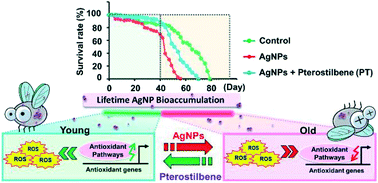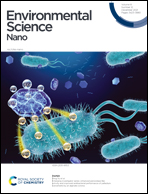Lifetime bioaccumulation of silver nanoparticles accelerates functional aging by inactivating antioxidant pathways, an effect reversed by pterostilbene†
Abstract
Engineered nanoparticles raise safety concerns. Silver nanoparticles (AgNPs) exert acute and chronic adverse effects by inducing reactive oxygen species (ROS)-mediated stress signaling pathways. We investigated the mechanisms by which AgNPs exert lasting adverse effects on longevity, as well as their sublethal effects on functional aging. Drosophila was used as a model to systematically study the mechanisms of small AgNP-induced acute and long-term toxicity. We demonstrated that dietary exposure to 12.5 nm AgNPs during early life increases cytotoxicity and animal lethality by strongly inducing ROS production. Early life exposure to AgNPs leads to increased lifetime bioaccumulation later in life and dose-dependent adverse effects on functional aging; e.g., shortened lifespan and loss of stress resistance and intestinal integrity. AgNPs inactivate antioxidant pathways in old, not young, animals, which increase susceptibility to ROS stress. Moreover, pterostilbene (PT), a methoxylated resveratrol, reversed the negative effects of AgNPs on longevity and age-related function by reducing ROS and upregulating antioxidant pathways. Thus, lifetime bioaccumulation of AgNPs accelerates functional aging by inactivating antioxidant pathways and PT reverses these effects. Our findings provide insight into the mechanisms driving the toxicity of bioaccumulated AgNPs and help establish a scientific foundation to guide the safe use of AgNPs.



 Please wait while we load your content...
Please wait while we load your content...